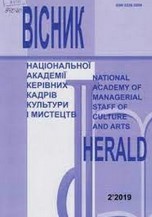ФЕНОМЕН ВЗАЄМОДІЇ ІТАЛІЙСЬКОЇ ТА АНГЛІЙСЬКОЇ ПРИДВОРНОЇ КУЛЬТУРИ В ПЕРШІЙ ПОЛОВИНІ XVII СТОЛІТТЯ
THE PHENOMENON OF THE INTERACTION BETWEEN ITALIAN AND ENGLISH COURT CULTURE IN THE FIRST HALF OF THE 17TH CENTURY
Author(s): Alla SokolovaSubject(s): Theatre, Dance, Performing Arts, Cultural history, 17th Century, Sociology of Art, History of Art
Published by: Національна академія керівних кадрів культури і мистецтв
Keywords: court culture; court mask; dance; Italian carnival; carnival mask; borrowed and creatively used;
Summary/Abstract: The purpose of the article is to identify the points of interaction between the English court culture and the Italian court culture of the first half of the 17th century and to highlight their characteristic features. The novelty of the study lies in understanding the interaction, similarities, and differences between the leading court genres of the Italian and English culture in the first half of the 17th century. The research methodology consists in applying the methods of analysis and synthesis, systematisation of facts, comparison, and generalisation of the research results. The systemhistorical method made it possible to consider the formation of Italian court culture in the Renaissance. The comparative method helped to reveal the similarities between court musical and theatrical performances in the above-mentioned countries. Conclusions. The attachment of the court culture of England, in general, and the genre of the English court mask, in particular, to the culture of the educated aristocracy of Italy, is verified by the cultural inclusion in the traditions of Italian carnival values and cult Italian dances. During the reign of the Stuart kings, the Italian carnival was well-known in England along with other European court entertainments. Italian dances, costumes, and scenery were used in court musical and theatrical performances in England. Italian choreographers and musicians were welcome guests at the Royal Palace of Whitehall, which contributed to the interaction and interpenetration of continental court culture with the culture of England. However, despite certain parallels between the court musical-theatrical entertainments of England and Italy, their difference was carried out due to the orientation of the performances to a narrow and, accordingly, wider circle of aristocratic participants.
Journal: Вісник Національної академії керівних кадрів культури і мистецтв
- Issue Year: 2022
- Issue No: 4
- Page Range: 67-72
- Page Count: 6
- Language: Ukrainian

